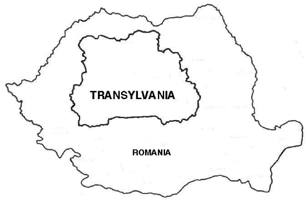
|
The Society of Folk Dance Historians (SFDH) Transylvania
[
Home |
About |
Encyclopedia | CLICK IMAGE TO ENLARGE |
BACKGROUND
Information: A region.
 Transylvania is a historical region which today is located in central Romania. Bound on the east and south by its natural borders, the Carpathian mountain range, historical Transylvania extended westward to the Apuseni Mountains. The term sometimes encompasses not only Transylvania proper, but also parts of the historical regions of Crișana and Maramureș, and occasionally the Romanian part of Banat.
Transylvania is a historical region which today is located in central Romania. Bound on the east and south by its natural borders, the Carpathian mountain range, historical Transylvania extended westward to the Apuseni Mountains. The term sometimes encompasses not only Transylvania proper, but also parts of the historical regions of Crișana and Maramureș, and occasionally the Romanian part of Banat.
The Hungarian minority is the largest ethnic minority in Romania. Most ethnic Hungarians of Romania live in areas that were, before the 1920 Treaty of Trianon, parts of Hungary. Encompassed in a region known as Transylvania, the most prominent of these areas is known generally as Székely Land (ținutul Secuiesc, Szekelyföld), where Hungarians comprise the majority of the population, comprising Harghita and Covasna counties and parts of Mureș county.
Many Hungarians living in Transylvania were disconcerted when the referendum held in Hungary in 2004 on the issue of giving dual-citizenship to ethnic Hungarians living abroad failed to receive enough electoral attendance and the vote was uncertain. Some of them complained that when they are in Hungary, they are perceived as half-Romanians, and are considered as having differences in language and behavior. However, a large proportion of Transylvanian Hungarians currently work or study in Hungary, usually on a temporary basis. After 1996, Hungarian-Romanian economic relations boomed, and Hungary is an important investor in Transylvania, with many cross-border firms employing both Romanians and Hungarians. In 2010 some amendments were passed in Hungarian law facilitating an accelerated naturalization process for ethnic Hungarians living abroad; among other changes, the residency-in-Hungary requirement was waived.
Popular Dances: De-a Lungul, Rarul, Jocul Fecioresc, Învîrtita
Language: In localities where they make up more than twenty percent of the population, Hungarians have the right to use their native language with local authorities.
Religions: Predominantly Reformed and Roman Catholic.
DOCUMENTS
- Balkans, a region.
- Codrenesc din Șomcuta, a dance.
- De a Lungul, a dance.
- Hungary, a country.
- Mezöségi Táncok, a dance.
- Romania, a country.
- Rustemul, a dance.
This page © 2018 by Ron Houston.
Please do not copy any part of this page without including this copyright notice.
Please do not copy small portions out of context.
Please do not copy large portions without permission from Ron Houston.